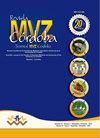Detección de anticuerpos anti-Mycobacterium avium subsp. paratuberculosis (MAP) en venados silvestres en Colombia
IF 0.3
4区 农林科学
Q4 AGRICULTURE, DAIRY & ANIMAL SCIENCE
引用次数: 0
Abstract
Objective. To determine the presence of anti-Mycobacterium avium subsp. paratuberculosis (MAP) antibodies in white-tailed deer (Odocoileus virginianus) and red brocket deer (Mazama rufina), captured in the Orinoquia and Caribbean regions of Colombia. Materials and methods. A total of 44 blood serum samples from deer of species M. rufina and O. virginianus were collected under field conditions between 2014 and 2016. An ELISA commercial kit was used to detect anti-MAP antibodies. An animal was considered ELISA-positive at a sample-to-positive ratio (S/P%) of ≥ 0.4, as recommended by the manufacturer. Results. The 50% (22/44) of the animals were positive, corresponding to 10 females and 12 males. An 81.8% (18/22) and 77.3% (17/22) of these seropositive animals were captured in the Orinoquia region and were reported as adults, respectively. Conclusions. It is not known how or when MAP was introduced in the Colombian deer population in the study regions. The most plausible hypothesis to explain the presence of antibodies against MAP in these wild populations is transmission by contact with infected bovine cattle since, in both regions, these species share pastures. This is the first study to explore MAP infection in wild animals in Colombia. These findings support the need for further studies using different direct diagnostic techniques and research approaches that allow the definition of links in the infection dynamics between wild and domestic mammals in Colombia.禽分枝杆菌亚种抗体的检测。哥伦比亚野生鹿的副结核(MAP)
目标。目的:测定抗鸟分枝杆菌亚种的存在。在哥伦比亚奥里诺基亚和加勒比地区捕获的白尾鹿(Odocoileus virginianus)和红小鹿(Mazama rufina)中发现副结核抗体。材料和方法。2014 - 2016年野外采集鹿群血清44份,其中鹿群为rufina和O. virginianus。ELISA商用试剂盒检测抗map抗体。按照制造商的建议,当样品阳性比(S/P%)≥0.4时,认为动物elisa阳性。结果。50%(22/44)的动物呈阳性,雌性10只,雄性12只。Orinoquia地区捕获阳性率为81.8%(18/22),成年阳性率为77.3%(17/22)。结论。目前尚不清楚MAP是如何或何时被引入研究地区的哥伦比亚鹿种群的。解释这些野生种群中存在抗MAP抗体的最合理假设是通过与受感染的牛接触传播,因为在这两个地区,这些物种共享牧场。这是探索哥伦比亚野生动物中MAP感染的第一项研究。这些发现支持需要使用不同的直接诊断技术和研究方法进行进一步研究,以便确定哥伦比亚野生和家养哺乳动物之间感染动态的联系。
本文章由计算机程序翻译,如有差异,请以英文原文为准。
求助全文
约1分钟内获得全文
求助全文
来源期刊

Revista Mvz Cordoba
农林科学-奶制品与动物科学
CiteScore
0.70
自引率
0.00%
发文量
41
审稿时长
6-12 weeks
期刊介绍:
The Journal MVZ Córdoba is an open access international scientific journal financed and edited by the University of Córdoba (Colombia). The journal publishes quarterly, continuously in PDF, XML, Epub, original articles, literature reviews, brief communications and clinical cases, peer-reviewed (double-blind) in Spanish and English, which are related to the agricultural and veterinary sciences. The journal is directed to natural and legal persons of veterinary medicine, animal husbandry, public health, epidemiology, aquaculture, biology, basic biomedical sciences and biotechnology and constitutes a space for academic and scientific discussion around the work of professionals in Veterinary Medicine and Zootechnics. Four-monthly publication.
"The Journal MVZ Córdoba supports the policies for registration of clinical trials of the World Health Organization (WHO) and the International Committee of Medical Journal Editors (ICMJE), since it recognizes the importance of these initiatives for international registration and dissemination. of information about clinical studies, in open access. As a result, since 2007, the journal MVZ Córdoba only publishes clinical research articles that have received an identification number in one of the Clinical Trial Registries validated by the criteria established by WHO and ICMJE, whose addresses are available in the ICMJE website. The identification number is recorded at the end of the summary. "
 求助内容:
求助内容: 应助结果提醒方式:
应助结果提醒方式:


